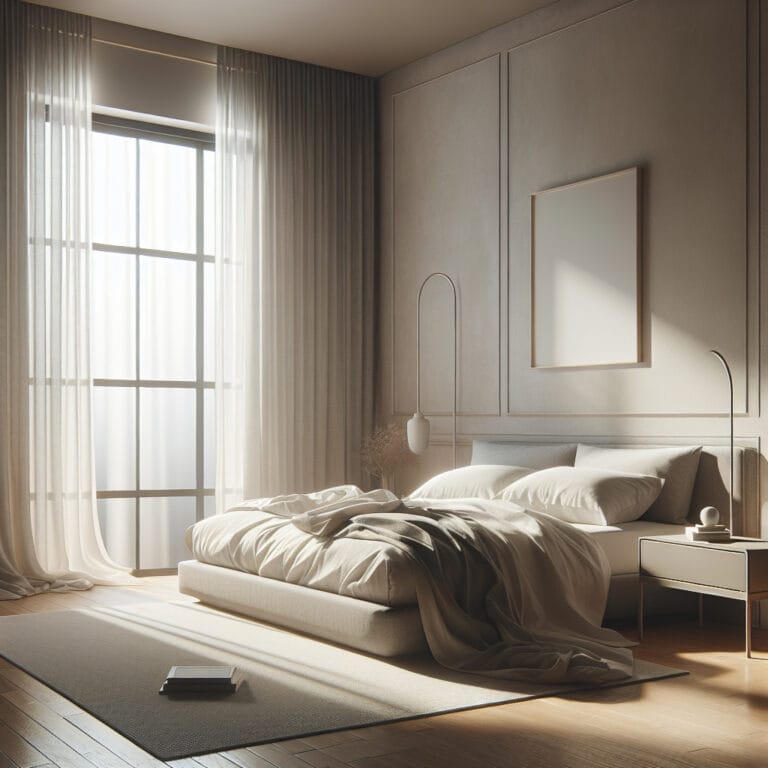
Embracing Minimalist Living: How Simplifying Your Space Can Improve Sleep Hygiene
Table of Contents
- Introduction to Minimalist Living and Sleep Hygiene
- The Science of Clutter and Sleep Disturbance
- Practical Tips for Embracing Minimalist Living
- The Benefits of Minimalism Beyond Sleep
- Real-Life Success Stories
- Overcoming Challenges in Adopting a Minimalist Lifestyle
- Conclusion
- Frequently Asked Questions
Introduction to Minimalist Living and Sleep Hygiene
Embracing a minimalist lifestyle extends far beyond an aesthetically pleasing home; it’s a transformative journey that can significantly enhance both sleep quality and overall well-being. By cultivating an environment centered on simplicity and intentionality, individuals discover the profound impact of minimalist living on sleep hygiene—an essential facet of health often overlooked in our fast-paced society. Studies have shown that poor sleep hygiene is intricately linked with various sleep disorders, from insomnia to sleep apnea, culminating in detrimental effects like daytime sleepiness and compromised cognitive function.
Incorporating minimalism into one’s life inherently promotes good sleep hygiene by fostering environments conducive to restful nighttime slumber. Clutter-free spaces reduce stress and mental distractions, assisting individuals in unwinding effectively before bedtime—a critical recommendation for improving sleep. Moreover, the minimalist philosophy encourages adherence to individualized sleep hygiene recommendations such as establishing a regular sleep schedule, which aligns circadian rhythms and mitigates the risks associated with poor sleep quality.
But the benefits don’t stop at dusk. Minimalist living also advocates for engaging in exercise training during daylight hours—another pillar of excellent sleep hygiene education—which has been proven effective in decreasing daytime napping among older adults who typically suffer from fragmented night rest. For young adults experiencing intense academic or professional pressures, reducing physical clutter can translate into diminished psychological clutter, thus expediting the process to fall asleep while enhancing subjective sleep quality through decreased anxiety.
Furthermore, awareness surrounding minimalism intersects with personalized strategies aimed at combatting specific concerns such as preventing nighttime awakenings due to noise or light disturbances—an approach akin to tailored interventions for those grappling with chronic conditions impacting their slumber.
Ultimately, adopting minimalist habits offers more than just an uncluttered space—it represents a powerful tool for optimizing individualized routines that actively support robust sleeping patterns free from common complaints of fitfulness or inadequate duration. It is not merely about subtracting possessions; it’s about adding quality—notably to one’s nightly repose—affirming that less truly can be more when it comes to achieving rejuvenating rest vital for healthful vigor throughout each waking day.
The Science of Clutter and Sleep Disturbance
Amid the hustle and bustle of modern life, minimalist living emerges as a sanctuary for tranquil slumber, artfully intertwining the essence of sleep hygiene with serene simplicity. As we dive into the psychology behind clutter and its nefarious effects on rest, it becomes evident that a clean, curated space is more than an aesthetic choice—it’s a vital component of maintaining commendable sleep quality. Scientific studies corroborate this link, revealing how decluttered environments serve as nurturing grounds for uninterrupted nighttime sleep and improved subjective sleep quality.
The harmony between minimalism and optimal rest extends deep into our physiology; by honoring individualized recommendations such as establishing a regular sleep schedule, minimalism aligns our circadian rhythms with natural cycles—paving the way for a reprieve from the grip of daytime napping and frequent awakenings during the night. This disciplined approach to life resonates particularly with older adults who often wage battles against fragmented sleep patterns and various sleep disorders. Yet it also holds profound relevance for young adults whose stress-induced poor sleep hygiene can lead to debilitating bouts of daytime sleepiness.
In lightening one’s physical environment, we inadvertently lift mental burdens too—this paves a smoother path to fall asleep by mitigating anxiety that so commonly feeds into poor sleep habits. Such intentional living can be instrumental in combatting chronic conditions like insomnia or even obstructive sleep apnea by fostering tranquility conducive to improving overall health. Through minimalist practices promoting good exercise training during daylight hours—one aspect of comprehensive education in improving sleeping habits—we witness another tangible benefit: minimized disruption due to external disturbances such as noise or light—a common impediment among those suffering from severe impact on their nocturnal rest.
By adopting a minimalist lifestyle that advocates for personalized strategies tailored to each unique set of needs—including those aimed at preventing or managing specific complaints associated with poor quality slumber—the capacity to enjoy rejuvenating rest becomes attainable. Embracing minimalist tenets goes beyond superficial de-cluttering; it equips individuals with tools essential for sustaining robust health through better control over one’s sleeping environment—an unassuming yet powerful ally against the specter of insufficient or disturbed repose.
In summary, minimalist living offers an empowering blueprint for enhancing one’s life through refined focus—not just clearing out excess possessions but creating spaces that inherently support sound slumber free from common hindrances like stress-induced disruptions. It underscores a pivotal truth: when it comes to enriching our lives through superior restorative rest, less can often yield infinitely more.
Practical Tips for Embracing Minimalist Living
Amidst the clutter and chaos that often characterize modern living spaces, minimalist living stands out as a beacon of tranquility and order, with profound implications for both mental well-being and sleep quality. The embrace of minimalist principles goes hand-in-hand with improved sleep hygiene, offering a quieter mind and a more restful bedroom environment conducive to deep, restorative slumber. Expert opinions in the field of interior design suggest that decluttering your sleeping quarters is not merely an aesthetic choice but a transformative health decision that can mitigate sleep disorders and enhance subjective sleep quality.
To foster an optimal nighttime environment within the minimalist framework, it’s beneficial to integrate color psychology into your decor choices. Cool tones like soft blues and greens evoke calmness and serenity—colors known for their ability to lower heart rate and blood pressure, thus contributing positively to falling asleep more swiftly. By combining these hues with pared-down furnishings free from superfluous detail or ornamentation, one reinforces a state of relaxation necessary for combating daytime napping or disturbances rooted in stress.
Moreover, an understated bedding setup does more than simply please the eye; it actively enhances sleep hygiene by reducing potential distractions that might lead to poor sleep quality or exacerbate existing conditions such as insomnia or obstructive sleep apnea. Simplifying bed linens—opting for soft textures without intricate patterns—and choosing supportive yet unobtrusive pillows allow older adults as well as young people who may struggle with maintaining regular sleep schedules due to life pressures to improve their overall sleeping experience.
The individualized approach inherent in minimalist living extends beyond just physical alterations—it encompasses personalized strategies addressing specific issues related to poor sleep hygiene education such as exercise training earlier in the day or minimizing technology usage before bedtime. These adjustments work synergistically with one’s circadian rhythms ensuring rejuvenating nighttime rest while countering complaints like daytime sleepiness or frequent nocturnal awakenings commonly associated with various types of interrupted night repose.
In essence, adopting minimalism is tantamount to curating one’s own sanctuary designed specifically for promoting excellent sleep hygiene recommendations. As awareness grows regarding how our surroundings impact our capacity for sufficient restful slumber—an issue particularly pertinent among those grappling with different forms of poor sleep—the simple yet deliberate lifestyle embodied by minimalism offers invaluable insights on creating harmonious environments where good quality rest becomes less an aspiration and more a daily reality.
| Aspect | Details | Benefits |
|---|---|---|
| Bedroom Decluttering | Remove unnecessary items and reduce clutter in sleeping quarters. | Improves mental well-being, sleep quality, and mitigates sleep disorders. |
| Color Psychology | Use cool tones like soft blues and greens in decor. | Creates calmness, lowers heart rate and blood pressure, aids in falling asleep. |
| Minimalist Furnishings | Choose simple, unadorned furniture to promote relaxation. | Reduces stress-related disturbances and promotes restful sleep. |
| Simplified Bedding | Opt for soft textures and supportive pillows without intricate patterns. | Enhances sleep hygiene, reduces distractions, and is beneficial for all ages. |
| Personalized Strategies | Incorporate sleep hygiene practices like earlier exercise and reduced pre-bedtime technology use. | Aligns with circadian rhythms, reduces daytime sleepiness, and prevents nocturnal awakenings. |
| Overall Minimalist Approach | Adopt a customized minimalist lifestyle to foster a conducive sleep environment. | Creates a sanctuary for excellent sleep hygiene and ensures restful slumber becomes a daily reality. |
The Benefits of Minimalism Beyond Sleep
Amid the modern world’s cacophony, minimalist living emerges not only as a design preference but also as a beacon of wellness, offering an oasis that markedly improves sleep quality and overarching life satisfaction. The correlation between minimalism and enhanced well-being is no mere coincidence; it’s rooted in how this lifestyle cuts through the noise—literally and figuratively—to foster environments where stress and anxiety dissipate. By stripping away the superfluous, individuals cultivate spaces that are not just physically easier to maintain but also emotionally uplifting; each cleared surface and each item purposefully chosen can contribute to a profound sense of calm, improving sleep hygiene by creating tranquil settings conducive to restful nighttime sleep.
Moreover, the less-is-more approach central to minimalist philosophy extends its benefits into everyday productivity. The absence of clutter translates directly into minimized distractions—each object in a minimalist space intends to serve either function or joy, eliminating the visual chaos that hampers concentration. This increased focus can lead to boosted productivity, with many finding that a decluttered environment encourages clearer thinking patterns and better decision-making ability—a boon for both older adults looking for serenity and young adults seeking clarity amid their bustling lives.
The ease with which one can clean and care for a home adorned with minimalistic sensibilities cannot be understated. With fewer items occupying space, cleaning becomes less time-consuming—a practical advantage leading to more opportunities for exercise training or engaging in other activities that positively impact sleep quality. Such maintenance simplicity inherently supports good sleep hygiene education by reducing potential allergens or irritants that could disturb restful slumber.
In essence, embracing minimalist living aligns harmoniously with individualized sleep hygiene recommendations promoting regular sleep schedules while mitigating common complaints such as daytime napping due to poor sleep quality. It addresses various facets contributing to improved subjective sleep quality—from combatting stress-related disturbance factors linked with conditions like insomnia or obstructive sleep apnea—to adhering closely to one’s circadian rhythms ensuring rejuvenating nighttime repose.
Minimalist living stands out as an actionable choice impacting every aspect of physical health and mental clarity; its principles touch upon multiple areas essential for combating not just symptoms associated with disturbed slumber but fostering an overall state conducive to thriving—inside our homes and within ourselves.
| Benefit | Description | Impact Area |
|---|---|---|
| Improved Sleep Quality | Minimalist environments reduce stress and anxiety, leading to better sleep hygiene and restful sleep. | Wellness & Sleep Hygiene |
| Increased Productivity | Less clutter minimizes distractions, enhancing focus and decision-making abilities. | Work & Daily Life |
| Easier Maintenance | Fewer items to clean leads to reduced housekeeping time, allowing for more leisure or productive activities. | Home Care & Personal Time |
| Better Health | Simpler cleaning reduces potential allergens or irritants, supporting good sleep hygiene. | Health & Sleep Quality |
| Stress Reduction | A minimalist approach combats stress-related issues like insomnia or obstructive sleep apnea. | Mental Health & Sleep Disorders |
| Alignment with Circadian Rhythms | Consistent living spaces and routines promote adherence to natural sleep-wake cycles. | Biological Clock & Sleep Patterns |
| Overall Well-Being | Principles of minimalism foster physical health and mental clarity, contributing to a thriving lifestyle. | General Health & Life Satisfaction |
Real-Life Success Stories
Embracing minimalist living can be the reset button for those wrestling with sleep disturbances and poor sleep hygiene. Imagine stepping into a room where simplicity reigns—where every object has purpose, and there’s space to breathe. This is the foundation of a lifestyle that fosters improved sleep quality, a precious commodity in our fast-paced world. Among older adults, for whom sleep disorders like insomnia and sleep apnea often loom large, the tranquility of minimalist spaces can significantly reduce nighttime awakenings and daytime napping—this is not mere conjecture but the lived experience of countless individuals who have seen their slumber transform.
Testimonies abound from young professionals plagued by daytime sleepiness due to erratic schedules; upon transitioning to minimalist habits, they report an astounding improvement in achieving regular sleep schedules and experiencing restorative nighttime sleep. It’s as if decluttering their space parallels an uncluttering of their minds, allowing them to fall asleep with ease amidst the serene ambiance that minimalism cultivates. These personal accounts illuminate how adopting minimalist principles aligns seamlessly with individualized recommendations for enhancing subjective sleep quality.
The influence on circadian rhythms cannot be overstated; good sleep hygiene becomes less of a goal and more of a natural outcome when one’s surroundings encourage calmness and systematic routines conducive to improving sleeping patterns. Moreover, incorporating exercise training during daylight hours complements this holistic approach by ensuring physical exertion doesn’t impede one’s ability to wind down come nightfall.
While it might seem contradictory at first glance—the act of paring down one’s belongings having such a profound impact on something as complex as our nightly rest—the correlation between reduced material excess, increased mental clarity, and consequent positive changes in health behavior is potent. Minimalist living isn’t just about shedding possessions; it’s about enriching lives through better health practices—one peaceful night at a time.
This lifestyle shift provides more than just anecdotal success stories; it offers concrete evidence that making intentional choices about our environments can decisively improve not only our slumber but also our overall well-being.
Overcoming Challenges in Adopting a Minimalist Lifestyle
Minimalist living, often pictured as a realm of stark rooms and spartan lifestyles, surprisingly cradles the key to unlocking better sleep quality and overall well-being. Far from being an austere aesthetic choice, the minimalist philosophy serves as a bedrock for solid sleep hygiene education. By reducing environmental chaos, individuals pave the way for fewer sleep disturbances and enhanced subjective sleep quality. This is particularly beneficial to older adults who might grapple with age-related sleep disorders or young adults whose irregular schedules foster poor sleeping habits.
The connection between minimalism and improved sleep is underpinned by science; orderly spaces are known to impact sleep positively by minimizing stress triggers that lead to nighttime awakenings or extended bouts of daytime napping. Moreover, adhering to a regular sleep schedule—easily facilitated in a minimalist home—supports our natural circadian rhythms, thus mitigating the effects of daytime sleepiness brought on by poor sleep hygiene.
In a consumer-driven society where accumulation often seems synonymous with success, maintaining minimalism requires conscious effort—a deliberate paring down that not only improves nightly rest but also acts against the tide of material excess that can lead to clutter-induced stress. The challenge lies in discerning what truly serves us—what possessions merit space in our lives—and resisting the lure of unnecessary acquisitions.
Navigating this path necessitates strategies such as mindfulness about purchases and establishing rituals around decluttering—an ongoing process rather than one-off exercise training for improving living conditions. In fostering awareness around individualized needs and health requirements like combatting specific complaints related to various types of poor quality slumber—including insomnia or obstructive apnea—the minimalist approach contributes richly towards ensuring each night’s repose deeply refreshes body and mind alike.
Conclusion
Unlock the serenity of minimalist living to combat sleep disorders and embrace a restful lifestyle. A minimalist home, marked by its uncluttered spaces and functional beauty, fosters an environment that champions good sleep hygiene. Such simplicity goes beyond aesthetics; it sets the stage for improved sleep quality, allowing both young adults and older generations to fall asleep with ease—free from the distractions that contribute to poor sleep hygiene. By adhering to individualized sleep hygiene recommendations within these tranquil confines, such as maintaining a regular sleep schedule and engaging in daytime exercise training, those suffering from daytime napping or nighttime disturbances can find solace. Minimalism doesn’t just impact sleep—it harmonizes with our circadian rhythms and mitigates the effects of sleep deprivation through enhanced subjective sleep quality. Venture into this understated yet profound lifestyle shift; let minimalism guide you toward peaceful nights and vibrant mornings, proving that when it comes to improving your rest, less is indeed more.


